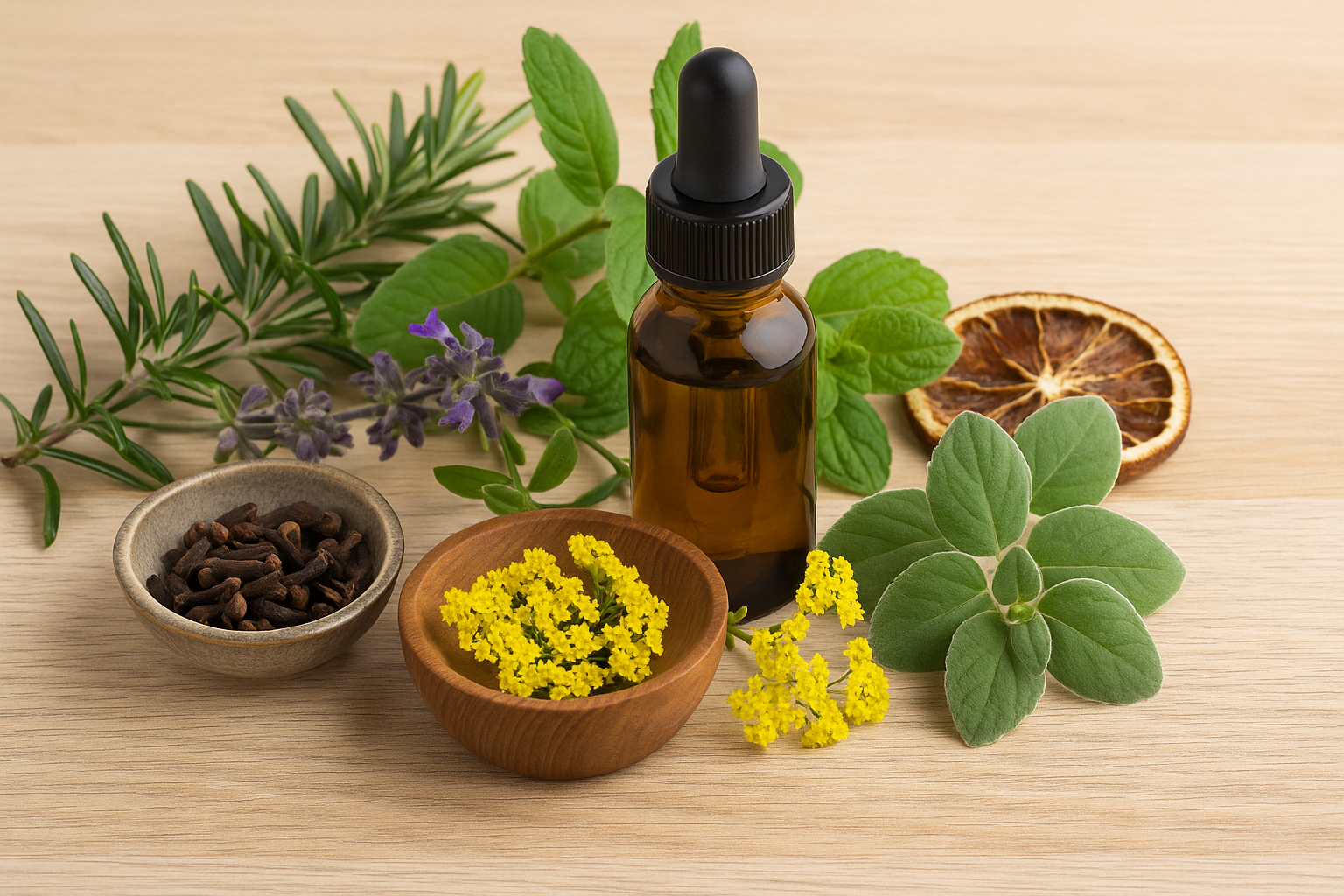Seasons change the way a home feels and smells. In Southern Brazil, Gaúcho herbs offer a natural way to follow that rhythm.
By blending native plants with weather, light, and mood, you can compose scents that match each season’s energy.
Seasonal fragrance is more than decoration. It is a practice of attention. It uses marcela, rosemary, boldinho, guaco, carqueja, white sage, and other regional plants to refresh air, calm evenings, and energize mornings.
Why seasonal scents matter
Temperature shifts how aroma travels. Warm air lifts essential oils quickly. Cold air holds scent close to fabrics and wood.
Matching blends to climate makes fragrance last longer and feel more natural.
Seasonal scents also mark time.
They create rituals that help families enter spring with clarity, hold summer with freshness, welcome autumn with depth, and cross winter with comfort.
Core Gaúcho herbs for fragrance
Marcela brings sweet calm and soft floral warmth. It suits evenings and slow mornings in cool months.
Rosemary cuts through heavy air with clarity. It brightens study spaces and midday kitchens.
Boldinho provides mint-like freshness. It excels in humid rooms and summer routines.
Guaco adds a sweet herbal note with gentle depth. It supports breathing during weather shifts.
Carqueja contributes dry, earthy bitterness.
It anchors blends and reduces stuffiness.
White sage delivers a smoky, resinous profile. It resets air and mood at turning points.
Tools and bases you will use
Use three simple carriers for most blends. Water infusions create room sprays. Light oils such as almond or jojoba carry body and linen oils.
Neutral alcohol (vodka or perfumer’s alcohol) fixes top notes for longer projection.
Have cotton cloths, small glass bottles with misters, amber jars, and paper tags. Keep a permanent marker to date every batch. This discipline is part of the craft.
Structure of a seasonal blend
Think in layers. Top notes open fast and set the first impression. Middle notes shape the heart and mood. Base notes linger on fabrics and wood.
With Gaúcho herbs, rosemary and boldinho often serve as top notes. Marcela and guaco form the middle. Sage and carqueja behave as base anchors. Ratios can start at 3–5–2 and adjust by season.
Spring fragrances
Mood and climate
Spring is bright and windy in the Pampas. Days start cool and end warm. You want clarity without harshness and energy without rush.
Signature profiles
Aim for green, airy, and floral. Combine rosemary brightness with marcela’s gentle bloom. Add a small earthy thread so the scent doesn’t fly away too fast.
Spray recipe Spring Clear Air
Lightly crush 2 tbsp fresh rosemary. Add 1 tbsp dried marcela. Pour 300 ml hot water. Cover 30 minutes. Strain. Add 1 tsp alcohol. Bottle and label. Use in bedrooms at sunrise and in study corners at noon.
Oil recipe First Light Body Oil
Fill a 120 ml bottle with 90 ml jojoba. Add 1 tbsp dried marcela and 1 tsp dried guaco. Infuse in a warm, dark place for 2 weeks. Strain. Finish with 6 drops rosemary essential oil if available. Apply on wrists before work.
Simmer pot Spring Window Day
In a saucepan, combine 2 rosemary sprigs, 1 tbsp marcela, and strips of lemon peel. Simmer on low with windows open. The room feels washed and new.
Linen refresher Bright Sheets
Brew a strong marcela tea. Cool. Mix 1 cup tea with 1 cup distilled water and 1 tsp alcohol. Mist curtains and sheets in the afternoon sun.
Summer fragrances
Mood and climate
Summer brings heat, humidity, and heavy kitchen air. Scents should be clean, quick, and cooling. They must cut through steam and linger without turning sweet.
Signature profiles
Lead with boldinho for fresh lift. Support with rosemary for edge. Ground with a hint of carqueja to keep structure.
Spray recipe River Breeze Kitchen
Steep 2 tbsp boldinho and 1 tbsp rosemary in 350 ml hot water for 25 minutes. Strain. Add 1 tsp alcohol and a pinch of sea salt to round the spray. Mist after cooking and near the entryway.
Water bowl Summer Bow
Rinse 6 boldinho leaves. Place in a ceramic bowl with cool water and 3 thin slices of cucumber. Set near the stove or by a fan. Replace water daily.
Oil recipe Midday Cooling Pulse
In 60 ml almond oil, infuse 1 tbsp boldinho for 10 days. Strain. Add 4 drops rosemary essential oil if available. Dab lightly on temples and the back of the neck before tasks.
Simmer pot Late Heat Reset
Use a wide pan with 2 cups water, 2 rosemary sprigs, and a crushed boldinho leaf. Bring to a bare simmer. Turn off heat. Let steam drift while doors are open.
Autumn fragrances
Mood and climate
Autumn is transitional. Air dries. Evenings stretch. Kitchens slow down. Scents can be deeper and rounder, with herbal sweetness and soft bitter tones.
Signature profiles
Blend marcela and guaco for a mellow heart. Stabilize with carqueja. Allow rosemary to exit the top gently.
Spray recipe Field Walk Evening
Steep 1 tbsp marcela and 1 tsp guaco in 300 ml hot water for 35 minutes. Strain. Add 1 tsp alcohol. Mist living rooms before dusk. The scent holds on wood and books.
Oil recipe Harvest Hands
Infuse 2 tbsp carqueja in 120 ml jojoba for 2 weeks. Strain. Blend with 1 tbsp marcela-infused oil if you have some from spring. Massage into hands after washing dishes. The aroma is earthy and reassuring.
Simmer pot Warm Light
Use 1 tbsp marcela, 1 tsp guaco, a small strip of orange peel, and a tiny pinch of cinnamon. Simmer on low. The sweet herb note keeps the spice in check.
Drawer sachets Autumn Quiet
Fill cotton bags with equal parts dried marcela and carqueja. Press once daily to refresh aroma. Replace after three months.
Winter fragrances
Mood and climate
Winter contracts the body. Windows stay shut. Air grows stale. Fragrance must be warm, steady, and cleansing without sharpness.
Signature profiles
Let white sage guide the base. Thread marcela through the middle for comfort. Use a small rosemary top so the room does not feel heavy.
Spray recipe Hearth Calm
Steep 1 tbsp marcela and a thumbnail of crushed sage leaf in 300 ml hot water for 30 minutes. Strain well. Add 1 tsp alcohol. Mist blankets and thick curtains at sunset.
Bundle ritual Winter Threshold
Tie a slim sage bundle with cotton string. Air-dry two weeks. On Fridays, open windows, light the bundle, and guide smoke from the back of the home to the front door. Extinguish safely. The scent resets the week.
Oil recipe Fireside Linen Oil
Combine 80 ml almond oil with 1 tbsp dried marcela and ½ tsp crushed sage. Infuse two weeks. Strain through fine cloth. Add 3 drops rosemary essential oil if available. Rub a single drop between palms and smooth over wool throws.
Simmer pot Quiet Night
1 tsp sage leaf, 1 tsp marcela, and a thin apple slice in a small pot. Bring to steam. Turn off. The aroma is round, dry, and calm.
Ratios and adjustments by weather
On hot days, push top notes to 5 parts and reduce base to 1 part. On cold days, invert the approach with 2 parts top and 4 parts base. During storms or high humidity, emphasize boldinho and rosemary. During dry, static days, lean on marcela and guaco for softness.
If a blend feels thin, add a pinch more carqueja. If it feels flat, add a fresh rosemary sprig at the moment of use. Keep notes so you can reproduce results.
Room-by-room seasonal mapping
Bedrooms prefer marcela all year, rosemary only in the early morning, and sage merely at thresholds. Kitchens carry boldinho and rosemary in spring and summer, then marcela and carqueja in autumn and winter. Living rooms enjoy guaco with marcela in cool months and boldinho with a lemon peel twist in warm months. Bathrooms like quick rosemary mists and small carqueja sachets.
Workspaces benefit from strict seasonal shifts. Spring uses rosemary dominant. Summer uses boldinho dominant. Autumn blends equal rosemary and marcela. Winter leans on marcela with a hint of sage for steadiness.
Fixatives and longevity
Alcohol extends spray life. Start with 1–2% by volume. Glycerin at 0.5% softens sprays on fabrics. Sea salt at a tiny pinch rounds sharp edges. For oils, a few drops of natural vitamin E slow oxidation. Always label bottles with date, season, and formula.
Sourcing, drying, and storage
Harvest in the morning when oils are high and dew is gone. Dry in shade with airflow. Never dry in direct sun. Store in amber jars away from heat. Replace dried stock at the start of each season so your palette is lively.
If you buy herbs, favor small producers who can tell you the harvest month. Ask how they dried the plants. Aroma begins with their method long before your blend.
Safety and sensitivity
Dilute essential oils if you use them. Keep smoke rituals short and windows open. For babies, elderly, pregnant people, or those with respiratory sensitivity, choose water infusions, gentle mists, and open-window simmer pots. Test fabric sprays on a hidden corner first. Mark “no-spray” zones like pet bedding and specific pillows.
Troubleshooting your blends
If scent disappears fast, raise the base note or add fixative. If a room smells muddy, remove one middle note and simplify. If sprays smell herbal but not clean, add a thin citrus peel to the infusion during steeping and remove before bottling. If bowls go stale, refresh daily and relocate to brighter airflow.
Rituals that anchor the year
Mark seasonal shifts with three acts. Swap sachets and label the date. Prepare a fresh signature spray and write the formula. Perform a brief doorway cleansing with sage or rosemary steam. The home remembers these gestures and people look forward to them.
Teaching and sharing
Make blending a family craft night. Assign roles for steeping, straining, and labeling. Give small bottles as gifts with handwritten instructions. Seasonal fragrance becomes a social thread that strengthens bonds and passes knowledge forward.
Advanced ideas for depth
Create macerated tinctures with neutral alcohol for stable concentrates. Use small ceramic diffusers on radiators in winter to release gentle aroma. Layer scent: a simmer pot for the base, a spray for the heart, and a bowl of leaves for the top. The space feels composed, not loud.
Seasonal calendars at a glance
Spring favors rosemary top, marcela heart, and a whisper of carqueja base. Summer favors boldinho top, rosemary support, and almost no base. Autumn favors marcela and guaco middle with carqueja structure. Winter favors sage base, marcela middle, and slim rosemary top used sparingly.
Print a one-page calendar and tape it inside a cupboard. It guides quick decisions when time is short.
Cost, sustainability, and mindset
One rosemary plant gives a full year of top notes. A handful of marcela, properly dried, supports dozens of sprays. Reusable bottles and cloths cut plastic waste. Seasonal thinking reduces impulse purchases because you already know what the home needs next.
Sustainability here is not a slogan. It is a set of repeatable habits tied to season, land, and attention.
Conclusion
Seasonal fragrance with Gaúcho herbs is a living craft. It watches the sky. It notes the wind. It chooses marcela for softness, rosemary for light, boldinho for freshness, guaco for breath, carqueja for shape, and sage for renewal.
By composing for spring, summer, autumn, and winter, you align scent with climate and mood. You replace noise with nuance. You perfume rooms while caring for health and memory. Each bottle and bowl becomes a small ceremony. Each season becomes a chapter you can read with your nose and your breath.

Marcela Cardozo is passionate about Southern Brazilian traditions and the cultural stories carried through natural scents. She blends knowledge of native herbs, essential oils, and regional rituals to create practical and inspiring content. Her writing connects ancestral wisdom with modern living, offering readers simple ways to bring authenticity, well-being, and meaning into their everyday lives.
